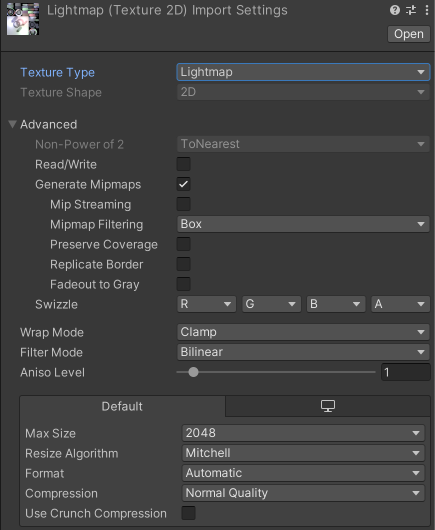Lightmap Import Settings reference
The Lightmap texture type formats the texture asset so it’s suitable to use as a LightmapA pre-rendered texture that contains the effects of light sources on static objects in the scene. Lightmaps are overlaid on top of scene geometry to create the effect of lighting. More info
See in Glossary. This option enables encoding into a specific format (RGBM or dLDR depending on the platform) and a post-processingA process that improves product visuals by applying filters and effects before the image appears on screen. You can use post-processing effects to simulate physical camera and film properties, for example Bloom and Depth of Field. More info post processing, postprocessing, postprocess
See in Glossary step on texture data (a push-pull dilation pass). Unity locks Texture Shape to 2D for this texture type. For more information, see Texture Shape.
Properties

| Property | Description | |
|---|---|---|
| Non Power of 2 | Specifies how Unity scales the dimension size if the texture source file has a non-power of two (NPOT) dimension size. For more information on NPOT dimension sizes, see Importing Textures. | |
| None | Texture dimension size stays the same. | |
| To nearest | Scales the Texture to the nearest power-of-two dimension size at import time. For example, a 257x511 px Texture is scaled to 256x512 px. Note that PVRTC formats require Textures to be square (that is width equal to height), so the final dimension size is upscaled to 512x512 px. | |
| To larger | Scales the Texture to the power-of-two dimension size of the largest dimension size value at import time. For example, a 257x511 px Texture is scaled to 512x512 px. | |
| To smaller | Scales the Texture to the power-of-two dimension size of the smallest dimension size value at import time. For example, a 257x511 px Texture is scaled to 256x256 px. | |
| Read/Write | Indicates whether to access the texture data from scripts using Texture2D.SetPixels, Texture2D.GetPixels and other Texture2D methods. Internally, Unity uses a copy of the Texture data for script access, which doubles the amount of memory required for the Texture. This property is therefore disabled by default, and you should enable it only if you require script access. For more information, see Texture2D. | |
| Generate Mipmaps | Indicates whether to generate mipmaps for this texture. | |
| Use Mipmap Limits | Disable this option to use all mipmap levels, regardless of the Mipmap Limit settings in the Quality menu. This property only appears if you set Texture Shape to 2D. Other texture shapes always use all mipmap levels. | |
| Mipmap Limit Group | Select the Mipmap Limit group this texture should be part of. The default option is None (Use Global Mipmap Limit). This property only appears if you set Texture Shape to 2D or 2D Array. Other texture shapes always use all mipmap levels. | |
| Mipmap Filtering | Specifies the method Unity uses to filter mipmaps and optimize image quality. This property is visible only when Generate Mipmaps is set to true. |
|
| Box | Makes mip levels smoother as they decrease in dimension size. | |
| Kaiser | Runs a sharpening algorithm on mipmaps as they decrease in dimension size. Use this option if your textures are too blurry when far away. The algorithm is of the Kaiser Window type. For more information, see Wikipedia. | |
| Preserve Coverage | Indicates whether the alpha channel in generated mipmaps preserves coverage during the alpha text. For more information, see TextureImporterSettings.mipMapsPreserveCoverage. This property is visible only when Generate Mipmaps is set to true. |
|
| Alpha Cutoff | The reference value that controls the mipmap coverage during the alpha test. This property is visible only when Preserve Coverage is set to true. |
|
| Replicate Border | Indicates whether to stop colors bleeding out to the edge of the lower MIP levels. This is useful for light cookies. This property is visible only when Generate Mipmaps is set to true. |
|
| Fadeout to Gray | Indicates whether mipmaps should fade to gray as the mip levels progress. This is useful for detail maps. The left-most scroll is the first mip level to begin fading out. The right-most scroll defines the mip level where the texture is completely grayed out. This property is visible only when Generate Mipmaps is set to true. |
|
| Ignore PNG Gamma | Indicates whether to ignore the gamma attribute in PNG files. This option is only visible if the texture source file is a PNG. |
|
| Wrap Mode | Specifies how the texture behaves when it tiles. | |
| Repeat | Repeats the texture in tiles. | |
| Clamp | Stretches the texture’s edges. | |
| Mirror | Mirrors the texture at every integer boundary to create a repeating pattern. | |
| Mirror Once | Mirrors the texture once, then clamps it to edge pixels. Note: Some mobile devices don’t support Mirror Once. In this case, Unity uses Mirror instead. |
|
| Per-axis | Provides options you can use to individually control how Unity wraps textures on the U and V axis. | |
| Filter Mode | Specifies how Unity filters the texture when the texture stretches during 3D transformations. | |
| Point (no filter) | The texture appears blocky up close. | |
| Bilinear | The texture appears blurry up close. | |
| Trilinear | Like Bilinear, but the texture also blurs between the different MIP levels. | |
| Aniso Level | Controls the texture quality when you view the texture at a steep angle. Anisotropic filtering is good for floor and ground Textures but is resource intensive. For more information, see Importing textures. | |
In addition, you can use the Platform-specific overrides panel to set default options and overrides for specific platforms.